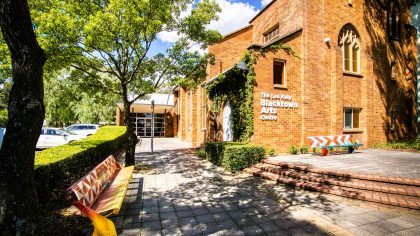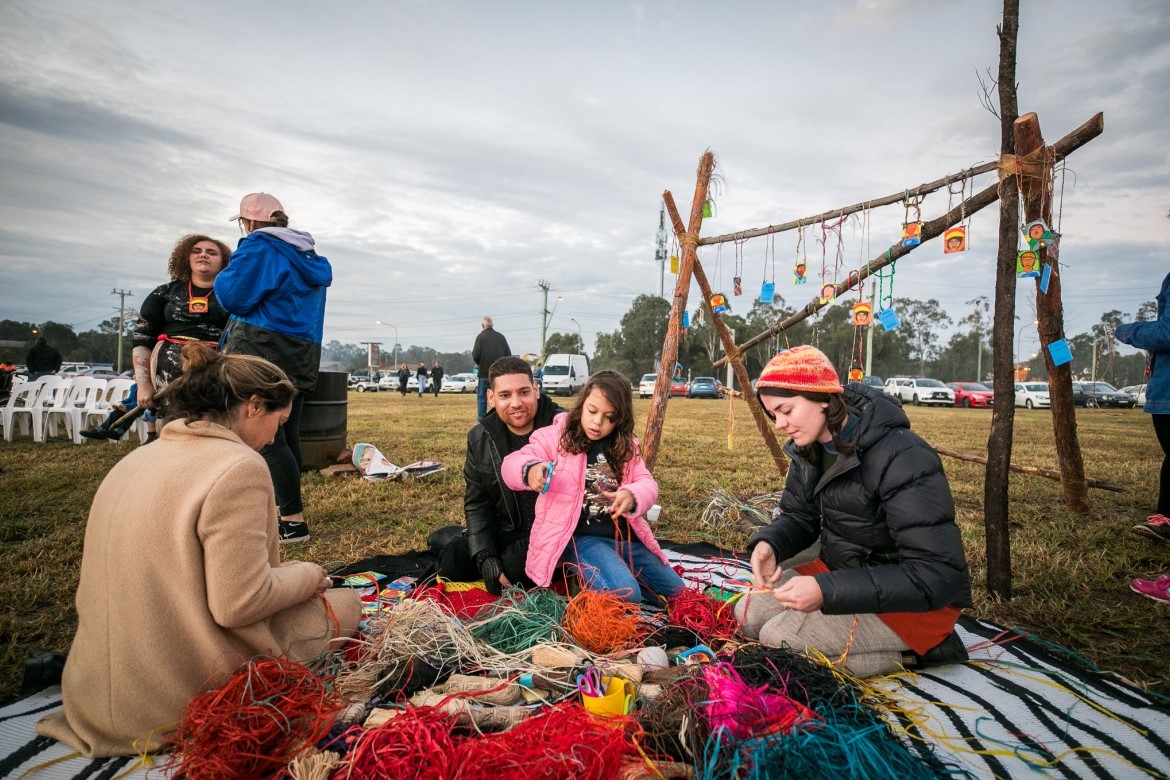
The Leo Kelly Blacktown Arts Centre
An innovative multi-arts hub in the heart of Blacktown City.
Bayadyinyang budyari Dharug yiyura Dharug Ngurra.
Bayady’u budyari Dharug Warunggadgu baranyiin barribugu.
Bayady’u budyari wagulgu yiyuragu Ngurra bimalgu Blacktown City. Flannel flowers dyurali bulbuwul.
Yanmannyang mudayi Dharug Ngurrawa. Walama ngyini budbud dali Dharug Ngurra Dharug yiyura baranyiin barribugu.
We acknowledge the Traditional Custodians of this Land, the Dharug people, and their continued connection to Country.
We pay our respects to Elders from yesterday to tomorrow.
We extend that respect to all Aboriginal and Torres Strait Islander Peoples of Blacktown City where the flannel flowers still grow proud and strong.
We will walk softly on this land and open our hearts to Country as the Dharug people have for tens of thousands of years.
Credit to: Dharug woman Rhiannon Wright, daughter of Leanne ‘Mulgo’ Watson Redpath and granddaughter of Aunty Edna Watson

A group of ebullient kids are giggling as they play tag on an open, grassy paddock, cornered by two busy roads and rows of McMansions. It’s a cold, grey afternoon, and people are huddled around large metal drums filled with fire.
Next to an enormous corroboree circle and a car spray painted with the words BLACK DEADLY, artist Tony Albert is busy hanging colourful lanyards to the large branches of a gunya or humpy. The lanyards have been drawn by local kids — on one side are portraits of children and on the other are hand-written vignettes, which reimagine 10 of the children originally at the Institution.
Warru, 16
He liked sitting
and talking and
listening to people.
Polly, 14
She likes dancing.
There is nothing of obvious interest about this vacant lot on the corner of Richmond and Rooty Hill Road North in Oakhurst. Yet for the crowds that are slowly arriving on this wintry day, this site is “ground zero”rfor the Stolen Generations. For it was here, in 1823, after moving from Parramatta, that the Black Native Institution was established. The residential school housed Aboriginal and Maori children — many of them who had been taken from their parents — with the goal of Christianising and Europeanising them.
The school is long gone. Burnt down, rebuilt and burned down again, the area where it once stood is now cordoned off by a large metal fence as the land is contaminated by lead. The site may contain archaeological evidence of life at the Institute but no work has been done.
In response to this sad history but also in an effort to move beyond it, the Blacktown Arts Centre, in collaboration with the Museum of Contemporary Art and other partners, have supported artists and the local community in “activating” the site since 2013.
Albert, 37, has strong connections to the Girramay and Kook Yalanji people in the rain forests of North Queensland. Now based in Sydney, he spent a year consulting with the local community and children to come up with the images as a way to reimagine the institutionalised kids. The public is invited to don one and contemplate the children as they walk around the paddock, and then write down their impressions, which are placed into a woven basket.
He says while the area was traumatic, it was also once a “significant and wonderful” place, where women came to have babies and hold ceremonies. “It’s not all super dark here,” he says.
Across the paddock is Darug woman Julie Bukari-Webb, who is preparing for the welcome ceremony. She’s surrounded by dancers, the women draped in mauve dresses, their shoulders covered in large possum skins. The possum is the totem for the Darug people but as it is illegal to kill possums, the skins are imported from New Zealand.
Darug land stretches from Mount Victoria to the mouth of the Hawkesbury River, a vast tract of valuable Sydney real estate. With no title to any of it, the locals have over time gravitated to this empty but significant lot. But as the site is heritage-listed and divided into five lots owned by various state government departments and Blacktown City council, to conduct ceremony on this scale, permission — largely related to usual bureaucratic issues such as risk management — is needed, a fact which saddens Bukari-Webb.
Nonetheless, she feels the red-tape surrounding the project has helped raise awareness that there needs to be greater flexibility in allowing the custodians to “go to their significant places and do their ceremony and cultural practices,” she says.
“This event feels like a big thing. It feels like a culmination of all these efforts that have been put together,” she says. “It’s pretty exciting to think about the effect it will have — masses of dancers and ceremony happening on site — not just for our mob but other mobs for the first time in years. It’s not just healing for this place, it’s healing for community, it’s healing for mobs that had people in institutions beside the Darug people.”
Mingling in the crowd is Uncle Wes Marne, a 96-year elder with the aura of a celebrity — a stream of people approach him to say hello and have a chat. Later on, in a large tent where crocodile soup, kangaroo sausages and damper with lilly pilly jam was being served alongside minestrone and burgers, Marne, in a large cowboy hat, sits sipping a cup of tea, still greeting people.
“I’m the storyteller. I’m the dreamtime storyteller. A storyteller is something that is handed down,” he says.
A Bigambul man from Queensland, fair-skinned Uncle Wes says he was forced onto a mission when he was ten years old. He moved to Sydney in 1960 and began telling stories in his backyard over a fire bucket but was closed down by police as laws at the time prevented groups of Aboriginal people converging together. He jokes that they not only arrested him, but his fire bucket, which was never returned.
An Aboriginal friend got him work in the school system but he was censored. “When they let me in, they said you can tell dreamtime stories but you are not allowed to talk about the first fleet or the stolen generation. You are not allowed to talk about any Aboriginal culture – only the dreamtime stories,” he says.
These days, Uncle Wes is back telling all sorts of stories with his fire bucket, and has appeared in events across the country. He also makes a small living “smoking” people’s houses in the Mount Druitt area for $50.
A great-great-great grandfather, he says his little ones keep him young. “I love looking around, and sometimes, I think these children have a lot to learn but they are learning,” he says. “We all have a lot to learn. I’ll be learning until the day that I die.”
Overlooking the event are an enormous posie of aqua green flannel flowers, a memorial to the institutionalised children, which was created by artist Sharyn Egan, who worked with Baabayn Aboriginal Corporation and local weavers.
As the night falls, the Moogahlin Performing Arts takes to the large dancing circle nearby. The performance work has been co-curated by Lily Shearer, an artist from the self-declared Murrawarri Republic, an area which straddles the Queensland and New South Wales border.
Shearer says the dance is a celebration of survival. “It’s the 21st century. People should know about the Stolen Generations by now,” she says. “We wanted to look at and celebrate land and people pre BC — ‘Before Cook’ and now. What are the kids doing in Mt Druitt right now?”
Out on the corroboree circle, dramatically lit by red and yellow light, the air filled with the sound of techno beats fused with didgeridoo, the kids are dancing.